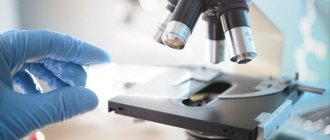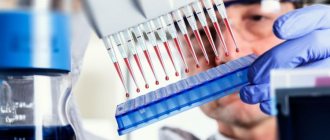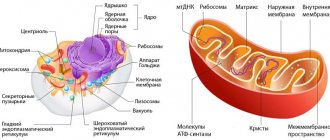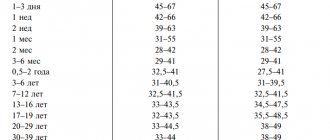24138 May 13
IMPORTANT!
The information in this section cannot be used for self-diagnosis and self-treatment.
In case of pain or other exacerbation of the disease, diagnostic tests should be prescribed only by the attending physician. To make a diagnosis and properly prescribe treatment, you should contact your doctor. We remind you that independent interpretation of the results is unacceptable, the information below is for reference only
General PSA (general prostate specific antigen): indications for use, rules for preparing for the test, interpretation of results and normal indicators.
Indications for the purpose of the study
Prostate specific antigen (PSA) is secreted by the epithelial cells of the prostate tubules.
In blood serum it is contained in two forms - free (10%) and associated with various antiproteases (90%). The free and bound fractions make up the total prostate specific antigen. It is known that PSA concentration increases with age. Prostate-specific antigen has several physiological functions: it liquefies the seminal clot after ejaculation, secretes a special substance that stimulates the contraction of the smooth muscles of the seminal vesicles, has an inhibitory (slowing) effect on cell growth, exhibiting anticarcinogenic and antiangiogenic effects.
An increase in serum PSA concentration in prostate cancer occurs due to the growth of tumor cells, destruction of the affected organ and entry of the antigen into the general bloodstream.
Serum PSA levels can increase not only in prostate cancer, but also in benign hyperplasia (BPH) and chronic prostatitis, so prostate specific antigen is an organ-specific, but not tumor-specific, marker.
PSA concentrations above 4 ng/ml are found in approximately 80-90% of patients with prostate cancer and in 10-20% of patients with prostate adenoma. An increase in PSA level does not always indicate a malignant process - what matters is the rate of increase in PSA concentration (in cancer this happens faster).
Risk factors for developing prostate cancer include genetic predisposition, a man's age, and dietary habits.
There is a relationship between the level of prostate specific antigen and the degree of malignancy of the process and metastasis. Thus, with a PSA value above 50 ng/ml, most patients may experience progression of the oncological process beyond the organ capsule and damage to regional lymph nodes.
Monitoring PSA concentrations helps specialists detect relapse (return of disease manifestations due to incomplete recovery) or metastasis (the process of formation of secondary foci of tumor growth (metastases) as a result of the spread of cells from the primary lesion to other tissues and/or organs). For example, after prostatectomy (removal of the prostate gland), PSA should be determined in the blood no higher than a residual concentration level of 0.05 to 0.1 ng/ml. PSA concentrations above this level may indicate residual tumor tissue or metastases. It is recommended to determine PSA 60-90 days after removal of the prostate due to possible false-positive results.
The effectiveness of therapy (for example, radiation, hormonal) is determined by a significant decrease in PSA concentration.
Thus, the indications for testing the level of prostate specific antigen are:
- early diagnosis of prostate cancer;
- decision on the advisability of performing a prostate biopsy;
- monitoring the course of the disease;
- assessment of the effectiveness of prostate cancer therapy;
- diagnosis of metastasis.
Reasons for raising a dog's level
An elevated PSA level indicates dysfunctional processes occurring in the prostate, most often of an oncological nature. But there are other reasons why the number of dogs increases:
- Action of infections. The protective functions of the tissues are disrupted, and the dog gets into the blood vessels.
- Male prostate hyperplasia, which is benign in nature. This occurs due to the pressure of the enlarged prostate tissue on healthy areas of this organ and the level of protein release in the blood becomes significantly greater.
- Exhaustive (in terms of time and intensity) physical loads.
- Interventions in the urological sphere of the male body - biopsy analysis, catheter installation.
- Palpatic examination or massaging of the prostate.
- Side effects of some drugs containing hormones.
By taking a blood test, you can determine whether the dog is normal, but the influence of the factors listed above should also be taken into account.
What can affect the result
If the preparation rules are not followed, the result obtained may be incorrect.
An increased PSA concentration can be observed within 10 days after a digital rectal examination, cystoscopy, colonoscopy, transurethral biopsy, prostatectomy or prostate massage, laser therapy, urinary retention, ejaculation on the eve of the study.
The level of total PSA can be affected by medications - androgen antagonists, allopurinol, finasteride, cyclophosphamide, methotrexate.
How is the analysis done?
Treatment of male oncology, prostate adenoma, should begin after a tumor marker has been carried out to clarify whether the level of PSA is elevated.
The test to determine whether a dog has prostate adenoma or other diseases is simple. In men, a sample is taken from a vein (in the morning - before 11 o'clock) and tested using an immunochromatograph. The antigen rate ranges from zero to four nanograms per milliliter of blood substance.
What number should you be afraid of and start treatment urgently? Increased standard for representatives of the male population:
- up to 40 years – more than 2.5 ng/ml;
- over 50 years old – over 3.5 ng/ml;
- at the age of 70-80 years – about 6.5 ng/ml.
Analysis is an excellent way to help the doctor understand the diagnosis and develop the right treatment. Symptoms of the disease will become less pronounced or disappear completely if the diagnosis and treatment measures are chosen correctly and the patient strictly follows the prescribed course.
The dog's norm is determined subject to certain conditions:
- Avoid sex two days before the test.
- Wait two weeks after prostate massage or insertion of a catheter into the bladder.
- After a prostate biopsy, taking hormonal medications or anti-tumor medications, at least two months must pass.
- Do not eat food for eight hours before testing.
If you do not adhere to such recommendations, you can get false test results from the dog (the dog’s concentration level is increased) and treat the patient incorrectly. Unfortunately, studies do not differentiate between oncological and benign formations, but only state the dry numbers of a dog. Only every third man with a high level of PSA suffers from cancer, the other two out of three men are carriers of other prostate diseases.
Symptoms of difficulty urinating, pain in the perineum, abnormalities in the development of the prostate gland are factors that speak in favor of conducting a tumor marker.
Males who fear for their health while taking such a test can be reassured that such an examination is safe and cannot harm a person. The only damage that a patient undergoing the procedure can suffer is his mental state.
Actions to take when raising a dog's level
An increased dog standard does not always indicate the presence of cancer, but to completely exclude it, it is better to undergo additional examination:
- repeating the dog test;
- general blood analysis;
- sperm culture;
- palpation (rectally);
- Ultrasound of the prostate gland (transrectal);
- biopsy of prostate tissue.
Only by repeating some examinations can you confirm the diagnosis and undertake the only correct treatment. This is also necessary in order to reassure the patient if the dog is taller than normal, because many men panic after the test results are announced.
Important! All men over forty-five years old should have their PSA blood tested annually and visit a urologist.
When is a PSA test prescribed?
The PSA test is the most reliable in diagnosing malignant prostate tumors and other pathological changes (inflammation or infections). The main goal of the study is to identify oncology. Manipulation is recommended annually for men over fifty - this is a risk group. Early screening is indicated for patients with a burdened medical history (first-degree relatives had cancer).
The prostate gland consists primarily of glandular tissue. It produces a secretion that is part of the seminal fluid. The prostate is sensitive to the concentration of male hormones - androgens. Abnormalities in the organ may be associated with a diet that increases cholesterol levels in the blood. Doctors also associate incorrect production of testosterone and its conversion to dihydrotestosterone.
A referral for analysis may be given in case of complaints of painful and difficult urination, as well as in case of enlargement of the prostate and structural changes in its tissues. The therapist interprets the results together with the oncologist and urologist. Biomaterial—venous blood serum taken from the elbow vein at the bend.
Prostate cancer occupies one of the first places among possible oncological diseases among representatives of the stronger half of humanity. In the early stages, the disease occurs without pronounced symptoms, so no one pays attention to it. Emerging complaints indicate progression of the diagnosis. In this case, we can already talk about stage 3-4 cancer. Screening will help protect yourself from a dangerous disease.
Preparing for analysis
The procedure is carried out strictly on an empty stomach, but is not tied to a specific time of day. A PSA test can be taken in both public and private clinics. The reliability of the result largely depends on the patient’s preparation. The day before the procedure is necessary.
- Avoid everything fried, salted and smoked. Such food provokes the active production of substances similar to tumor markers.
- Eliminate physical and emotional stress. A stressful situation can radically change the functioning of the enzymatic system. You can't ride a bicycle.
- Do not smoke at least one hour before blood collection. Don't drink alcohol for at least a day.
- Medication intake is limited for two days. If this is not possible, be sure to notify the doctor about the names of the drugs.
- Avoid sexual intercourse for two days before the test.
- It is important that before the procedure at least 10 days have passed since the last prostate massage. After prostate surgery, PSA is taken no earlier than six months later.
In the referral for analysis, if necessary, indicate the presence of a confirmed diagnosis of prostate cancer, as well as information about previously performed medical procedures.
The study is carried out in a complete ELISA laboratory, which has a shaker-incubator, a washing device and a microplate photometer. Kits for PSA determination are produced by a number of Russian and foreign manufacturers. At the same time, domestic devices are not inferior to imported analogues in terms of accuracy. In terms of cost of analysis, they are many times more economical.
PSA norm
Standard values have been developed for tumor markers. However, they are for general information purposes only. Independent interpretation of the obtained laboratory data is not allowed. This can lead to worsening of the condition (even death).
| Patient age | Free PSA norm | Norm of bound PSA |
| 20-30 | Up to 0.4 | Up to 0.4 |
| 30-40 | Up to 0.4 | Up to 0.4 |
| 40-50 | 0,5-1,5 | 2,5-3 |
| 50-60 | 0,7-2,1 | 3,5-4 |
| 60-70 | 1,1-3,2 | 4,5-5,0 |
| Over 70 | 0,7-3,4 | 6,5-7,0 |
Standards may vary depending on the reagents and equipment used in each particular laboratory. A reduced level of a specific antigen indicates a minimal level of risk of malignant neoplasms. In overweight men, PSA levels may be lowered due to a decrease in the number of red blood cells in the plasma due to an increase in its total volume.
If the prostate biopsy does not reveal cancer and PSA continues to be high, a repeat biopsy will be required. As a rule, no earlier than after 3 months. If a patient is receiving hormonal treatment for metastatic cancer, follow-up tests are required once every 3 months.
Based on the test results, the dynamics of the development of the disease is assessed, so PSA is determined several times and must be combined with other examination methods.
Free PSA test
Free antigen is the active form that is not bound to blocking molecules. Some of the PSA protein that enters the blood binds to other proteins, the level of which can be measured. Prostate cancer cells (unlike soft tissue) no longer produce PSA. Therefore, in this situation, the percentage of free PSA is minimal.
Free PSA is a marker that has tissue specificity, not just cancer. The analysis is significant for screening examinations of large groups of patients. This is a safe and economical method.
To analyze total and free PSA, serum without foreign particles is used. The material can be stored at temperatures from +2 to +8° C for 24 hours. For longer storage (up to three months), the blood must be aliquoted and frozen. Secondary freezing and thawing should be avoided. After thawing, the samples are thoroughly mixed.
The biomaterial is placed in sealed tubes and sent for examination. Coagulation factors are first removed from the blood taken. Enzyme-labeled antibodies are then injected into the serum. They interact with free PSA and form a specific complex. The second step is the addition of a chemiluminescent substrate. A non-thermal glow is released, the intensity of which is recorded. The entire study takes a maximum of a few hours.









